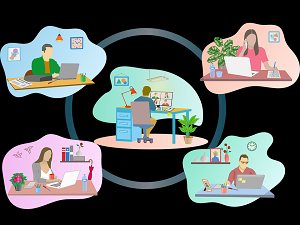Balancing Security and Operational Needs
Even if a team doesn't work from home, they still need to be able to access their employee accounts from home. The owners of businesses prioritize improving industrial remote access so that their workers can be flexible and productive while keeping the company's digital infrastructure safe. When you find a good balance between security and freedom, your system will be less likely to be hacked, and your business will grow.
Look at these attributes and choices:
Security vs. Flexibility
Regarding security and operational flexibility, you might feel you can have one but not the other, especially if your employees primarily work from home. But weak security measures will hurt your business in the long run.
Can you mix the two in a way that makes things work better and keeps people safe?
Flexibility allows workers to use software, view files, and talk to each other from anywhere. It can be hard to use and handle security measures from a distance. If you plan, you don't have to choose between one or the other.
Remote Security Solutions
Since flexible work has become more popular, different solutions have come to light. It was always important to be safe. But now, businesses want to give workers who work from home or on the road more freedom to do their jobs.
Company-Issued Hardware
Start with the devices themselves to improve workplace remote access. Companies can give out laptops, tablets, and phones to make remote control easy and protect their digital assets in advance. The security solutions picked by the company will work with the company's equipment.
Security Software Solutions
Most devices come with generic security software already installed. However, this software only sometimes works well for certain businesses. Software designers make security solutions like Cyolo to meet specific security needs while providing businesses the necessary freedom. These designer solutions are a big part of making workplace remote access stronger.
Strong Protection Policies
Next, ensure that everyone on your team does their part by implementing strong security policies. For example:
- Employees should only view internal files when using a device given to them by the company.
- Employees should only do work-related things on safe networks.
- Employees should get training regularly to learn about new threats and how to use security software.
Multi-Factor Authentication
Do your team members use usernames and passwords to get into business apps? These inputs aren't enough to protect their personal information or sensitive data connected to your business. Multi-factor authentication makes sure the person logging in is who they say they are by:
- Fingerprinting
- Facial scanning
- Voice recognition
- Text messages or calls
Encrypted Services
Malware from the outside can't read and understand the information in a file if it's encrypted. The following protected digital services will help your business:
- Knowledge bases
- Email networks
- Cloud storage
These services should only show material to people who can see it within your company's network.
Strengthening Remote Access
By ensuring your business's industrial remote access is better, you'll show your team how to keep malware and hackers from hurting important assets and people. Customers will feel better about your business if you have strong security plans.
Embrace the Future
People are more likely to buy from a company if they know their information is safe. For growth, finding a good mix between security and speed is important.
Additional Information
TechTarget: What is Remote Access?
Microsoft: Enable Remote Desktop on your PC
Please sign up for our newsletter above
By Denis Wilson

Thanks for reading this post. I always take into mind that your time and attention are precious. And these posts need to be timely, to the point, and short. For more tips on thriving with small business technology, check out the other blog posts at DWPIA Blogs. You can also find me on LinkedIn, YouTube, and Facebook.
I am also a published author and speaker on cloud computing, work-from-anywhere, and cybersecurity. I work extensively with business and professional associations to provide small business technology education programs.
Contact me if you have any questions about the subject. I'd be happy to spend 15 minutes discussing it with you.


